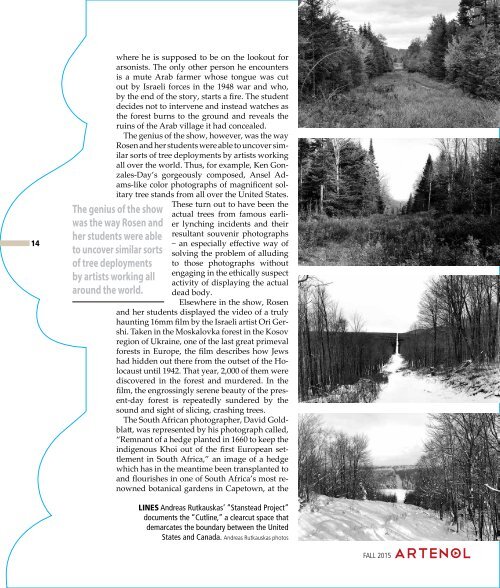Artenol_Fall_flipbook
Create successful ePaper yourself
Turn your PDF publications into a flip-book with our unique Google optimized e-Paper software.
14<br />
where he is supposed to be on the lookout for<br />
arsonists. The only other person he encounters<br />
is a mute Arab farmer whose tongue was cut<br />
out by Israeli forces in the 1948 war and who,<br />
by the end of the story, starts a fire. The student<br />
decides not to intervene and instead watches as<br />
the forest burns to the ground and reveals the<br />
ruins of the Arab village it had concealed.<br />
The genius of the show, however, was the way<br />
Rosen and her students were able to uncover similar<br />
sorts of tree deployments by artists working<br />
all over the world. Thus, for example, Ken Gonzales-Day’s<br />
gorgeously composed, Ansel Adams-like<br />
color photographs of magnificent solitary<br />
tree stands from all over the United States.<br />
These turn out to have been the<br />
actual trees from famous earlier<br />
lynching incidents and their<br />
resultant souvenir photographs<br />
− an especially effective way of<br />
solving the problem of alluding<br />
to those photographs without<br />
engaging in the ethically suspect<br />
activity of displaying the actual<br />
dead body.<br />
Elsewhere in the show, Rosen<br />
and her students displayed the video of a truly<br />
haunting 16mm film by the Israeli artist Ori Gershi.<br />
Taken in the Moskalovka forest in the Kosov<br />
region of Ukraine, one of the last great primeval<br />
forests in Europe, the film describes how Jews<br />
had hidden out there from the outset of the Holocaust<br />
until 1942. That year, 2,000 of them were<br />
discovered in the forest and murdered. In the<br />
film, the engrossingly serene beauty of the present-day<br />
forest is repeatedly sundered by the<br />
sound and sight of slicing, crashing trees.<br />
The South African photographer, David Goldblatt,<br />
was represented by his photograph called,<br />
“Remnant of a hedge planted in 1660 to keep the<br />
indigenous Khoi out of the first European settlement<br />
in South Africa,” an image of a hedge<br />
which has in the meantime been transplanted to<br />
and flourishes in one of South Africa’s most renowned<br />
botanical gardens in Capetown, at the<br />
The genius of the show<br />
was the way Rosen and<br />
her students were able<br />
to uncover similar sorts<br />
of tree deployments<br />
by artists working all<br />
around the world.<br />
LINES Andreas Rutkauskas’ “Stanstead Project”<br />
documents the “Cutline,” a clearcut space that<br />
demarcates the boundary between the United<br />
States and Canada. Andreas Rutkauskas photos<br />
FALL 2015

















